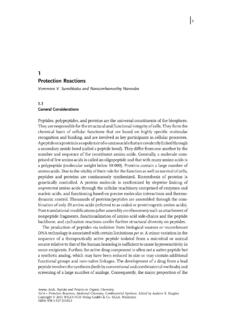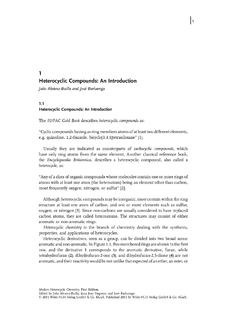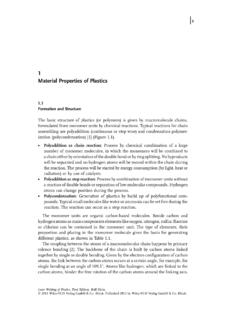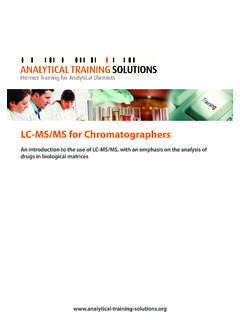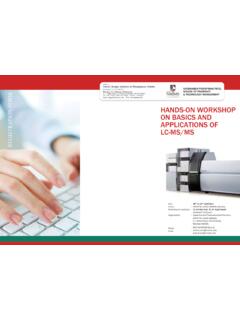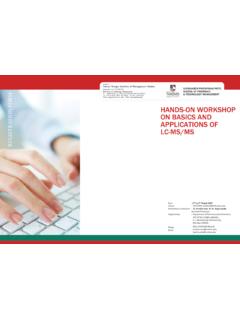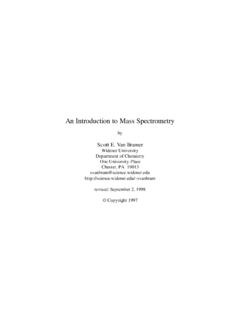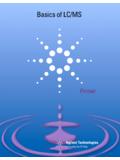Transcription of 1 IntroductiontoMassSpectrometry,aTutorial - …
1 11 Introduction to Mass Spectrometry, a TutorialWilfried Niessen and David the past 30 years, mass spectrometry (MS) has undergone a spectacular devel-opment, in terms of both its technological innovation and its extent of applica-tion. On-line liquid chromatography mass spectrometry (LC MS) has becomea routine analytical tool, important in many application areas. The introductionof electrospray ionization (ESI) and matrix-assisted laser desorption/ionization(MALDI) has enabled the MS analysis of highly polar and large molecules, includ-ing biomacromolecules. MS is based on the generation of gas-phase analyte ions,the separation of these ions according to their mass-to-charge ratio (m/z), and thedetection of these ions.
2 A wide variety of ionization techniques are available togenerate analyte ions (Section ). Mass analysis can be performed by six typesof mass analyzers (Section ), although quite frequently tandem mass spectrom-eters, featuring the combination of two mass analyzers, are used (Section ). Thedata acquired by MS allow quantitative analysis of target analytes, determinationof the molecular mass/weight, and/or structure elucidation or sequence determi-nation of (unknown) analytes (Section ).This chapter provides a general introduction to MS, mainly from a functionalpoint of view. Next to basic understanding of operating principles of ionizationtechniques and mass analyzers, the focus is on data interpretation and analyticalstrategies required in the study of biomolecular interactions using of MS experiment typically consists of five steps: (i) sample introduction, (ii) ana-lyte ionization, (iii) mass analysis, (iv) ion detection, and (v) data processing andAnalyzing Biomolecular Interactions by Mass Spectrometry,First by Jeroen Kool and Wilfried Niessen.
3 2015 Wiley-VCH Verlag GmbH & Co. KGaA. Published 2015 by Wiley-VCH Verlag GmbH & Co. Introduction to Mass Spectrometry, a Tutorialinterpretation of the results. Sample introduction may involve individual samplesor may follow (on-line) chromatographic separation. Mass analysis and ion detec-tion require a high vacuum (pressure 10 5mbar). Analyte ionization may takeplace either in high vacuum or at atmospheric pressure. In the latter case, a vac-uum interface is required to transfer ions from the atmospheric-pressure ioniza-tion (API) source into the high-vacuum mass analyzer its basic operation with on-line chromatography or other forms of continuoussample introduction, the mass spectrometer continuously acquires mass spectra,that is, the instrument is operated in the full-spectrum (or full-scan) mode.
4 Thismeans that a three-dimensional data array is acquired, defined by three axes: time,m/z, and ion intensity (counts). This data array can be visualized in different ways(Figure ). In thetotal-ion chromatogram(TIC), the sum of the ion counts in theindividual mass spectra are plotted as a function of time. Amass spectrumrepre-sents a slice of the data array of the ion counts as a function ofm/zat a particulartime point. Summed, averaged, and/or background subtracted mass spectra canbe generated. Mass spectra may be searched against libraries, when available, toassist in compound identification. In anextracted-ion chromatogram(XIC), thecountsfortheionwithaselectedm/zare plotted as a function of time. Them/zselection window may be adapted to the resolution of the mass spectrometer.
5 Ininstruments providing unit-mass resolution, the selection window in most cases is (u), whereas with high-resolution mass spectrometry (HRMS, seebelow) selection windows as small as 10 mu can be used (narrow-window XIC).In abase-peak chromatogram(BPC), the ion count recorded for the most abun-dant ion in each spectrum is plotted as a function of time. BPCs are especiallyuseful for peak searching in chromatograms with relatively high chemical back-ground. More advanced tools of data processing are discussed in Section figures of merit are relevant: mass spectrometric resolution, mass accu-racy, and the acquisition speed, that is, the time needed to acquire one spectrum(or one data point in a chromatogram). the fact that mass spectrometrists readily discuss (and boast) on the res-olution of their instruments, it seems that there is no unambiguous definitionavailable.
6 The IUPAC (International Union of Pure and Applied Chemistry) rec-ommendations [1] and ASMS (American Society for Mass Spectrometry) guide-lines [2] are different in that respect [3, 4]. Most people in the MS communitydefineresolutionasm/ m, wheremis the mass of the ion (and obviously shouldbe read asm/z)and mis either the peak width (mostly measured at full-widthhalf-maximum, FWHM) or the spacing between two equal-intensity peaks witha valley of, for instance, 10% [1]. The FWHM definition is generally used with allinstruments, except sector instruments where the valley definition is used. Theresolving poweris defined as the ability to distinguish two ions with a small differ-ence inm/zHowever, resolving power has also been defined asm/ mand Figures of Merit3(a)(b)(c)(d) (min) (min) (min)6001+ + + + + + + + + + + + min1 TICBPCXICm/z of the three-dimensional data array acquired in a full-spectrum MS experiment.
7 (a) Total-ion chro-matogram (TIC), (b) base-peak chromatogram(BPC), (c) extracted-ion chromatogram(XIC), and (d) mass spectrum. Data for anN-glycopeptide from the LC MS analysis of atryptic digest of a commercial immunoglobu-lin G (IgG) standard, analyzed using a DionexUltimate 3000 nano-LC coupled via ESI to aBruker Maxis Impact Q-TOF MS in the labora-tory of one of the authors (D. Falck).resolution as the inverse of resolving power [3]. The IUPAC definition is usedthroughout this a simple and straightforward way, mass analyzers can be classified aseither unit-mass-resolution or high-resolution instruments (see Table ). Forunit-mass-resolution instruments such as quadrupoles and ion traps, calculationof the resolution asm/ mis not very useful, as the FWHM is virtually constantover the entire mass Introduction to Mass Spectrometry, a TutorialTable and features of different mass )MassaccuracyFull-spectrumperformanceb)S elected-ionperformanceb)Pressure(mbar)Qu adrupoleUnit-mass +++<10 5 Ion-trapUnit-mass +++10 5 Time-of-flight 70 000<3 ppm++ <10 7 Orbitrap 140 000<1 ppm++ <10 9FT-ICR 400 000<1 ppm++ <10 9 Sector 60 000<3 ppm+++<10 7a) Resolution based on FWHM definition, except for sector (5% valley definition).
8 B)++, instrument highly suitable for this operation;+, instrument less suitable for thisoperation; and , instrument not suitable for this operation (post-acquisition XIC possible). AccuracyIn MS, the mass of a molecule or them/zof an ion is generally expressed as amonoisotopic mass (molecular mass) orm/z, referring to the masses of the mostabundant natural isotopes of the elements present in the ion or molecule. In chem-istry, the average mass or molecular weight is used, based on the average atomicmasses of the elements present in the molecule. Theexact mass(or betterm/z)ofan ion is its calculated mass, that is, its theoretical mass. In this respect, the chargestate of the ion is relevant, because the electron mass ( mDa) may not be negli-gible.
9 Theaccurate mass(or betterm/z) of an ion is its experimentally determinedmass, measured with an appropriate degree of accuracy and precision. The accu-rate mass is the experimental approximation of the exact mass. Thenominal mass(or betterm/z) is the mass of a molecule or an ion calculated using integer val-ues for the masses of the most abundant isotopes of the elements present in themolecule or ion. Themass defectis the difference between the exact mass and thenominal mass of ion or molecule [1, 5].The achievable mass accuracy in practice depends on the resolution of the massanalyzer and the quality and stability of the calibration of them/zaxis. An instru-ment providing unit-mass resolution generally allowsm/zdetermination forsingle-charge ions with an accuracy of u (nominal mass determination).
10 InHRMS, themass accuracyis generally expressed either as an absolute mass error(accurate mass exact mass, in mu) or as a relative error (in ppm), calculatedfrom(accurate mass exact mass)(exact mass) 106In HRMS of small molecules, the error inm/zdetermination will typically be inthe third decimal place (accurate mass determination).From the accuratem/zof an ion, one can use software tools to calculate itspossible elemental compositions. The number of hits from such a Figures of Merit5obviously depends on them/zvalue, the number of elements considered, andthe mass accuracy achieved [6]. The number of hits may also be reduced bytaking an accurately measured isotope pattern of the ion into consideration[7, 8]. For a given ion withm/zM, the relative abundances of the ions withm/zM+1, M+2, and M+3 reveal the presence (or absence) and even the numberof specific elements, for example, Cl, Br, and S from the M+2 ion.
